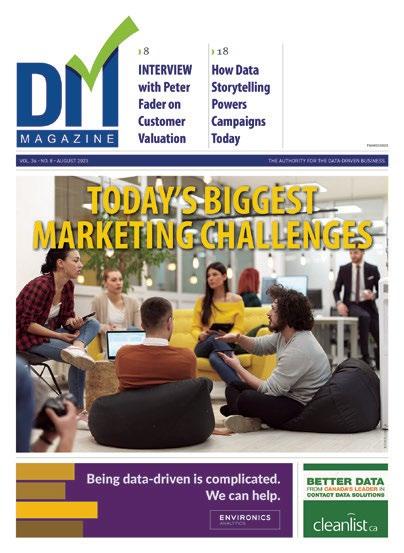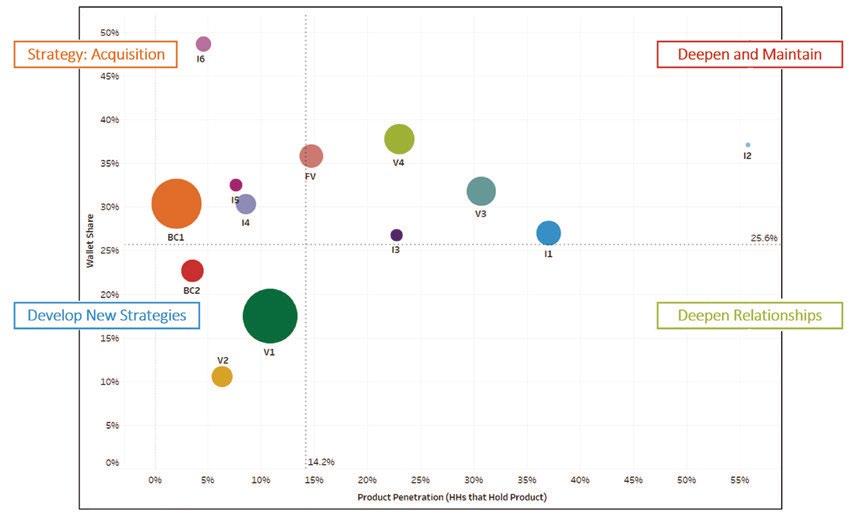Being data-driven is complicated. We can help.



VOL. 36 • NO. 9 • SEPTEMBER 2023 THE AUTHORITY FOR THE DATA-DRIVEN BUSINESS PM40050803 ❱ 8 Brainstorming Marketing Innovation ❱ 10 Digital Transformation: An Interview with Howard Tiersky ISSUE
ISTOCK/PHOTOSCHMIDT THE
IT’S HERE. CAN WE USE IT WISELY?
We’ll Help You Keep It Clean
Dealing with bad data is a task no marketer needs on their checklist. Inaccurate, outdated, and duplicate records can build up in your database, affecting business decisions, the customer experience, and your bottom line. As the Address Experts, Melissa helps our customers improve their direct marketing efforts with the best Address Veri cation, Identity Veri cation and Data Enrichment solutions available. We validated 30 billion records last year alone, which is why thousands of businesses worldwide have trusted us with their data quality needs for 37+ years.
BAD DATA BUILDUP
Returned Mail & Packages
Missed Opportunities
Decreased Customer Insight
DATA CLEANLINESS
Real-time Address Veri cation
Change of Address/NCOA Processing
Geographic & Demographic Data Appends
Contact us for a Free Proof of Concept and ask about our 120-day ROI Guarantee.
Trust the Address Experts to deliver high-quality address veri cation, identity resolution, and data hygiene solutions.

Melissa.com 800.MELISSA (635-4772)
Vol. 36 | No. 9 | September 2023

PRESIDENT Publisher & Editor-in-Chief
Steve Lloyd - steve@dmn.ca
DESIGN / PRODUCTION

Jennifer O’Neill - jennifer@dmn.ca
ADVERTISING SALES

Steve Lloyd - steve@dmn.ca

CONTRIBUTING WRITERS
Annette Chacko
Justin Cook
Danny Edsall
Judith Platz
LLOYDMEDIA INC.
Stephen Shaw Tanuj Singh Jagadish Upadhyaya
HEAD OFFICE / SUBSCRIPTIONS / PRODUCTION:

302-137 Main Street North Markham ON L3P 1Y2
Phone: 905.201.6600
























Fax: 905.201.6601 • Toll-free: 800.668.1838 home@dmn.ca • www.dmn.ca
EDITORIAL CONTACT:
DM Magazine is published monthly by Lloydmedia Inc. DM Magazine may be obtained through paid subscription. Rates: Canada 1 year (12 issues $48)
2 years (24 issues $70)
U.S. 1 year (12 issues $60)
2 years (24 issues $100)
DM Magazine is an independently-produced publication not affiliated in any way with any association or organized group nor with any publication produced either in Canada or the United States. Unsolicited manuscripts are welcome. However unused manuscripts will not be returned unless accompanied by sufficient postage. Occasionally DM Magazine provides its subscriber mailing list to other companies whose product or service may be of value to readers. If you do not want to receive information this way simply send your subscriber mailing label with this notice to: Lloydmedia Inc. 302-137 Main Street North Markham ON L3P 1Y2 Canada.
POSTMASTER:
Please send all address changes and return all undeliverable copies to: Lloydmedia Inc.
// 3 SEPTEMBER 2023 DMN.CA ❰
302-137 Main
Markham ON L3P 1Y2
Post
Mail Sales Product
Twitter: @DMNewsCanada NEXT ISSUE: What’s Next for the DM Agency? ❯ 4 Talking Points talkingpoints INTERVIEW
8 Are You Brainstorming Your Marketing Innovations? Special to DM Magazine
10 Digital Transformation: An Interview with Howard Tiersky, CEO of FROM CREATIVITY
14 A Welcome Disruptor: GenAI is Revolutionizing Customer Support
16 Gen AI goes Grocery Shopping
18 The Role of Artificial Intelligence in Marketing ❯ 22 Empowering Sales and Marketing with AI: The Rise of DataDriven Success TECHNOLOGY ISTOCK/PHOTOSCHMIDT ISTOCK/ZAMRZNUTITONOVI ISTOCK/IPOPBA ISTOCK/GMAST3R ISTOCK/SDECORET
Street North
Canada Canada
Canadian Publications
Agreement No. 40050803
❯
❯
❯
❯
❯
talkingpoints








ST. JACOBS, ON–Canadians can now earn Scene+ points at Home Hardware Stores Limited’s close to 1,100 locations across Canada and at homehardware.ca using their Scene+ Loyalty Card and the Scotiabank Scene+ Visa* Card.

With the addition of Home Hardware, Canada’s largest Dealer-owned home improvement retailer to the Scene+ roster, Canadians will earn rewards on tools, paint, hardware, lumber, building materials, furniture, and more.

“We are incredibly excited that Scene+ is now available at Home Hardware locations across the country,” said Kevin Macnab, President and CEO of Home Hardware Stores Limited. “Our Dealers are always looking for ways to bring value to their customers and now with Home Hardware joining Scene+, Canadians can instantly redeem points for the tools and products needed to complete their home improvement projects.”
Offer details:
❯ Canadians will earn 50 points for every $50 spent in a single in-store or online purchase at Home Hardware when using their Scene+ Loyalty Card.
❯ Canadians will earn 2x the points for every dollar spent at Home Hardware when paying with their Scotiabank® Scene+ Visa* Card.
❯ Canadians using their Scene+ Loyalty Card in tandem with their Scotiabank® Scene+ Visa* Card will earn both offers when they purchase from Home Hardware in-store or online.
❯ Every 1,000 Scene+ points can be redeemed for $10 off any purchase at Home Hardware stores or homehardware.ca.
“In the past few years, Scene+ has grown into the leading lifestyle loyalty program with the strategic addition of grocery, pharmacy and now, a premier home improvement partner,” said Tracey Pearce, President, Scene+. “We’re so proud to keep evolving by partnering with Home Hardware to give our members even more rewards for their home improvement projects.”
Scene+ has over 13 million members across the country and gives customers a wealth of options to earn and redeem points at a vast number of partners. Members can earn by banking with Scotiabank; enjoying a night out at Cineplex theatres and entertainment venues; visiting more than 700 Recipe Unlimited restaurants across Canada, including Swiss Chalet, Harvey’s, and Montana’s; and enjoying extraordinary experiences like trip planning with Scene+ Travel, Powered by Expedia. Redemption partners include retailers like Apple and Best Buy. Over the past year, Empire Company Limited (“Empire”) (TSX: EMP.A), co-owner of Scene+, launched the loyalty program in-store at its banners Sobeys, Safeway, Foodland, IGA, FreshCo, Chalo! FreshCo, Voilà by Sobeys/Safeway/IGA, Needs, Thrifty Foods, Les Marchés Tradition, Rachelle Béry, and Lawtons Drugs, as well as its liquor stores in Western Canada.
Home Hardware Stores Limited is Canada’s largest Dealer-owned hardware, lumber, building materials, and furniture home improvement retailer with close to 1,100 stores under the Home Hardware, Home Building Centre, Home Hardware Building Centre and Home Furniture banners. Founded in 1964 in rural St. Jacobs, Ontario, Home
Hardware remains 100 percent Canadian owned and operated.
TORONTO, ON–















Subway unveiled MVP Rewards, a refreshed loyalty program launching September 9 in Canada, the U.S., and Puerto Rico. The new and improved program gives Subway guests the MVP experience with more ways to earn, more perks, and more earning power as you ascend from Pro to Captain to All-Star status tiers*. Consumers can earn points by ordering their favourite sub in Subway restaurants, on Subway.ca or the Subway app. MVP Rewards replaces Subway MyWay® Rewards. All 30 million MyWay members across North America will be enrolled in the new program, and their unspent tokens will automatically be converted into points, giving them a head start on reaching status and earning MVP Rewards’ best perks. New members will receive 250 bonus points when they join**.
“Subway fans are the best in QSR and to thank them for their loyalty, we’re giving them the star treatment as MVP Rewards members,” said Mike Kappitt, Chief Operating and Insights Officer at Subway. “Consumer input helped inform our refreshed loyalty

// 4
■ ■ ■ ■ ■ ■ ■ ■ ■ ■ ■ ■ ■ ■ ■ ■ ■ ■















talkingpoints
program to create a best-in-class experience. MVP Rewards gives our guests more of what they love from Subway, with a few hidden surprises baked in, so every guest feels like an MVP and comes back to Subway more often for their favourite subs.”
As part of its loyalty refresh, Subway made the program easier for guests to sign up, earn and redeem points, as well as advance from Pro to All-Star. Besides craveworthy signature subs and meal upgrades, members at the Captain and All-Star tiers will soon have access to special Subway merchandise and members-only VIP exclusives:
❯ Pro – introductory tier, spending less than $200 per year
❯ 250 point signing bonus for new members
❯ 10 points per $1 spent on qualifying purchases
❯ 5 percent bonus points on mobile orders







❯ Members-only deals, bonus point days and earning challenges
❯ Birthday and anniversary rewards
❯ Captain – $200 annual spend
❯ All Pro tier benefits
❯ Better birthday and anniversary rewards
❯ 10 percent more points per $1 spent on qualifying purchases
❯ Exclusive bonus point days
















❯ Access to members-only Subway Swag Shop
❯ All-Star – $400 annual spend
❯ All Captain tier benefits
❯ Even better birthday and anniversary rewards
❯ 20 percent more points per $1 spent on qualifying purchases
❯ Free Chip Fridays – with purchase
❯ More bonus points days
❯ Access to members-only VIP exclusives –coming soon
To join Subway’s new MVP Rewards, use the Subway app or enter your phone number at the register when dining in restaurant starting September 9. For a complete overview of Subway MVP Rewards and Subway’s new loyalty program benefits, visit Subway.ca/ rewards
Subway® MVP Rewards available at participating restaurants. Points may not be earned on third-party delivery orders, ezCater catering orders, or purchases of gift cards.
TORONTO – PopReach Corporation, a multiplatform digital technology company, announced that its subsidiaries Schiefer Media, Inc. and Crucial Interactive Inc. (Contobox) are joining forces in order to streamline the delivery of personalized ad tech solutions for marketers within the scope of full-funnel ad campaigns that drive e-commerce, sales and digital marketing performance.
“This integration represents a major milestone in our plan to realize strong synergies between our companies that will allow us to better serve our customers,” says PopReach CEO, Jon Walsh. “Combining both the multiaward winning creative team at SCS and Contobox technology allows PopReach to deliver an unmatched marketing solution that will drive higher performance for our advertising partners.”
Today’s digital marketers are seeking consolidated ad tech solutions at a time when expanding consumer data privacy laws are challenging global brands to find new and innovative ways to deliver the customized and personalized ad experiences that resonate with consumers. In addition, the proliferation of AI-powered tools has accelerated the search for an efficient martech investment strategy across the organization. The integration of SCS and Contobox addresses both considerations.
The two companies will integrate across their platforms, production and media planning teams, as part of the development of a full-funnel media solution powered by Contobox Engagement Management Platform (EMP). Leveraging its machine learning, Dynamic Creative Optimization, True Intent and interactive Connected TV technologies, EMP drives higher performance for e-commerce brands across programmatic media and on-site display. Contobox has been awarded the Best Customer Data Platform by Digiday, with successes that include delivering a 9.7x increase in Return on Ad Spend (“ROAS”) for a prospecting campaign of a major big box retailer.
“We are incredibly excited about bringing SCS’s data-driven strategy, creative and integrated media services alongside Contobox’s powerful machine learning personalization platform,” says James Schiefer, Founder & CEO of SCS. “As a retail activation company that helps brands sell-through and drive e-commerce performance, the Contobox technology platform combined
with the SCS blend of media strategy and creativity is going to offer retailers and Directto-Consumer brands a full-service solution that improves ROAS, increases engagement and loyalty, and lowers the cost of marketing.”
Contobox will function as a technology platform product brand within the SCS portfolio. The Contobox platform team will operate within SCS and continue to evolve the Contobox product roadmap. Contobox Chief Executive Officer, Farrukh Gaffarov, will also take on the role of Chief Technology Officer at SCS to lead development for the combined platforms.
“The Contobox team has been on a mission since our product development in 2011 to leverage data and personalization to improve digital marketing and e-commerce outcomes,” says Farrukh Gaffarov. “Our team is looking forward to integrating with SCS, continuing to support our resellers and partners at the highest level, while driving the future of digital marketing through personalized creative, data insights, and machine learning technology.”
TORONTO, ON – Capital One Canada, the financial institution that has helped more than 4 million Canadians with access to credit, is introducing the new Capital One Smart Rewards Mastercard – the only Canadian credit card that celebrates and rewards customers for payments made toward their balance.
Smart Rewards cardholders can turn payments into rewards, earning points for every dollar paid toward their balance and they can redeem for options like gift cards and account credits, with no minimum redemption amount.
“While we have existing products designed to help Canadians access and build credit, we saw a need for a credit card that celebrates positive financial habits in a truly meaningful way. A card that goes beyond traditional reward offerings and supports the financial well-being of Canadians — in the immediate and, more importantly, in the long run,” says Patrick Ens, President of Capital One Canada. “That’s where the idea for the Smart Rewards Mastercard came from — a solution that helps customers succeed with credit so that they can reach their financial goals.”
All Capital One Canada credit cards, including Smart Rewards, come with helpful benefits, like price protection, purchase assurance, extended warranty, common carrier travel accident insurance, car rental collision/loss damage waiver, and baggage delay insurance
Made of recycled materials, the Smart Rewards Mastercard is part of Capital One Canada’s drive to have all new and
// 6 ❱ DMN.CA SEPTEMBER 2023
■ ■ ■ ■ ■ ■ ■ ■ ■ ■ ■ ■ ■ ■ ■ ■ ■ ■
■ ■ ■ ■ ■ ■ ■ ■ ■ ■ ■ ■ ■ ■ ■ ■ ■ ■
replacement cards issued using recycled plastics. This helps to reduce the amount of plastic that will eventually make its way into landfills, and underscores the company’s commitment to protecting the planet
“We understand that everyone is unique, with different lived experiences, each on their own financial journey, which is why we put customers at the centre of product design” says Ens. “Having the right access, tools and products is crucial to achieving one’s financial goals. We spend a lot of time getting to understand those needs and identifying how we can meet them best.”
The Smart Rewards Mastercard followed this approach and was designed, developed and refined after years of customer input. Capital One Canada uncovered insights from a number of activities including surveys, focus groups and their Coffee with Customers program, which seeks to build empathy for customers, to better understand their experiences, needs and real ways the company can help them succeed with credit.

When a product goes into market, there’s an opportunity to understand how users engage with it, what works and what doesn’t – and Capital One takes those learnings back into the development lifecycle, refines and, sometimes, relaunches to continue optimizing the best experience for their customers. Following this process, brand marketing for The Smart Rewards Mastercard will roll-out regionally, starting in select provinces across Canada.
TORONTO, ON–Hudson’s Bay relaunched Hudson’s Bay Rewards, with a new app that brings together the best of customer loyalty programs in a new, fun and valuable Rewards experience.
The Hudson’s Bay Rewards app delivers exclusive offers personalized to members based on preferences and shopping habits,
An All-Keynote Event The Future is Revolution
Ontario Bar Association Conference Centre, Toronto November 15, 2023 | 8:00 am to 4:00 pm Presented by DM Magazine
in-app ‘Quests’ that take members on a journey for higher returns, access to special events, and other perks.
As always, members earn rewards points by shopping in store or online at Hudson’s Bay and Zellers, as well as by using their Hudson’s Bay Mastercard anywhere Mastercard is accepted. Shoppers can achieve different levels of membership through a 3-tiered program: Hudson’s Bay Rewards, Rewards Plus, and Rewards VIP. The more points earned, the higher the level for increased earn and redemption rates.
New to the program is in-app quests, which are a series of linked milestones that, when all met, trigger a bonus. For example, a quest may be to build a head to toe outfit from Hudson’s Bay. The quest can be completed over an extended period of time, and progress can be tracked along the way. Once complete, a bonus is earned.
To redeem, points can be applied instantly to any purchase. Shoppers have access to thousands of national brands across beauty, home, apparel and accessories. Whether shopping back to school for kids, crossing off your Christmas shopping list, picking up the latest lipstick shade or treating yourself to a new Vitamix, no other Canadian loyalty program delivers the category range and brand scope under one roof as does Hudson’s Bay Rewards.
“Hudson’s Bay was one of the first to introduce a Rewards program in Canada, and since then we have seen tremendous change in how people are shopping, how they are prioritizing their purchases, and what they are looking for in a loyalty program,” said Kevin Parry, VP Credit and Loyalty at Hudson’s Bay. “We wanted to level up our rewards game — giving our customers an exceptional experience that essentially lets them earn more points faster, to redeem for the things they need and want for themselves and their families, and have some fun while doing it.”
The “AI in Marketing: A Revolution” conference is a ground breaking event at the forefront of the intersection between artificial intelligence (AI) and data-driven marketing. With AI rapidly reshaping the landscape of modern business, this conference brings together industry leaders, experts, and innovators to explore the transformative potential of AI. The all-keynote conference promises to be a pivotal event for anyone looking to harness the power of AI to drive innovation, growth, and success in the ever-evolving world of marketing. Join us for a transformative journey into the future of marketing powered by artificial intelligence.
Renowned thought leaders and executives from leading tech companies will shedding light on the latest trends, challenges, and opportunities in AI-driven marketing. Attendees will discover new research and practical case studies, showcasing how AI is revolutionizing data-driven marketing strategies, insight-based customer engagement, and brand loyalty experiences.
Speakers Include:
LOUIS CHO|Chief Experience Officer|Affinity Credit Union Hailing from Toronto, the founder of Nexus AI Inc. plays an integral role in applying digital best practices, marketing automation and artificial intelligence to enhance the member experience. With his leadership, ACU is using data in meaningful and innovative ways to support members in achieving their goals, today and for generations to come.
STEPHEN SHAW|Chief Strategy Officer|Kenna
Stephen guides clients on the adoption of customer experience management as a core discipline and serves as an advocate of marketing transformation. Recognized in Canada as an authority on relationship and database marketing, his expertise spans from information technology and customer analytics to customer management strategy.
And more. Check our website for updated details. www.dmn.ca/ai_in_marketing
// 7 DMN.CA ❰ SEPTEMBER 2023
■ ■ ■ ■ ■ ■ ■ ■ ■ ■ ■ ■ ■ ■ ■ ■ ■ ■

// 8 ❱ DMN.CA SEPTEMBER 2023 Are You Brainstorming Your Marketing Innovations? Special to DM Magazine CREATIVITY
Innovations?
B
rainstorming can be a great way to drive innovation in your business if you prepare for it properly. A session that falls flat can be a frustrating waste of time.
Brainstorming often gets a bad reputation because sessions sometimes generate humdrum ideas and tend to be dominated by higher-ranking or more outspoken participants. But that doesn’t have to be the case.
Define the problem
The first step should be to determine a problem question that the brainstorming session will address. The question should be clear and prompt participants to think of solutions, such as “How can we differentiate our services?” or “How can we increase production?”
Next, set boundaries for possible solutions. For example, solutions may have to be implemented within six months or involve finding a new market. “If you want a broad set of ideas, you’ll want fewer boundaries. If you’re looking for a very tight set of solutions, you’ll want tighter boundaries,” says Andrea Caulfield, Innovation Manager at BDC.
Lay out the context and definitions
Next, ask yourself what the participants already know about the context of the problem question and what else they need to know. Compile any additional information participants will need and send it to them or present it during the session. You will also need to establish definitions of key terms, so everyone is working from the same page. For example, let’s say your problem question is: How do we increase production? You need to define what you mean by production. Total number of units, or total number of defectfree units? How much do we want to increase production by? Can we add resources to support the solutions we generate or not?
Pick an appropriate facilitator
The facilitator should be someone who can keep the session on track, has experience with brainstorming and is unbiased. They should be able to make sure everyone participates and that no one dominates the discussion.
1 2 3 4
Invite the right people
Your session should include people in the company who are affected in some way by the problem question. It should also include experts on the topic being discussed and non-experts, such as employees in another area of the business or non-employees. Three to eight people is often ideal.
“Experts have the burden of expertise. It’s harder for them to go beyond what they know,” Caulfield says. “Non-experts have the lightness of being a beginner. They can ask silly questions or suggest unconventional ideas.”
To get a broad range of ideas, make sure to invite a diverse mix of participants from varying cultures, backgrounds, and age groups.
Set the agenda
First, devote enough time for setting out the problem question, boundaries, context and definitions. Caulfield suggests approximately 20 minutes.
Caulfield likes to divide the heart of the brainstorming into two parts—first, “diverging,” then “converging.” Diverging is when participants explore options and generate new ideas. This could take 30 minutes.
Converging is when ideas are sorted and discussed to isolate the best ones. Converging usually takes less time—perhaps 20 minutes. The final step is wrapping up the session, which could take 10 minutes.
5 6
Holding the session
Several techniques exist to structure the brainstorming. A simple one for the diverging component is for the facilitator to hand out sticky notes and give participants a few minutes to write down their ideas. The sticky notes are then put up on a wall or whiteboard.

The facilitator then reads the ideas one at a time, gets any needed clarification and, with the input of participants, groups them into three or four categories. If new ideas come up, these can be added on extra notes.
Converging can be accomplished by asking participants to put a checkmark or star by their favourite three to five ideas, depending on how many “top picks” you want to end with and how many people are in the room.
The output from the session can consist of a list of the most favoured ideas and any themes that emerge. In addition, the output should highlight any highly innovative ideas, even if they didn’t receive many votes.
All these ideas would be taken to a planning or strategy session to be looked at in more detail by a smaller group.
As a wrap-up, the facilitator should explain the next steps and what will happen to the group’s ideas. Participants should also receive a summary of the top ideas.
// 9 DMN.CA ❰ SEPTEMBER 2023 Brainstorming
Here are six steps to organize a winning brainstorming session.
CREATIVITY
ISTOCK/ZAMRZNUTITONOVI
DIGITAL TRANSFORMATION:

An Interview with Howard Tiersky, CEO of FROM
 BY STEPHEN SHAW
BY STEPHEN SHAW
There are many legacy companies today sleep walking toward their grave. They are about to be engulfed by a fast-approaching wave of momentous change which they are totally unprepared to face. It is no longer a question of whether market disruption will happen to their business — it is only a question of when. There will be no safe place to hide. No sector will be spared. Many companies will be simply swept away.
Some refer to it as the Fourth Industrial Revolution. Others call it the Age of Upheaval. Whatever you call it, the change will be so radical, so disruptive, so extensive that it will demand completely revolutionary thinking in order to avoid extinction. And revolution is just not in the vocabulary of most businesses. Companies much prefer the calm and predictability of business as usual.
For years now digitization has been on the corporate agenda as an operational necessity. The principal motivation has been modernization of the company’s operating model — how work actually gets done. Seeing no special urgency, companies have tended to move at a leisurely pace, satisfied with incremental gains in productivity and efficiency. Even then many of these modest transformation initiatives fail. In fact, it is estimated that just 30 percent of digital change initiatives ever succeed. Poor governance, lack of executive fortitude, pushback from internal naysayers, inadequate funding, thinly spread resources, competing priorities — all of these factors and more can sap the will of the project champions.
Now consider the even tougher odds of achieving profound transformation that calls for divergent thinking to succeed. This is the exact type of transformative change that will be essential in the years ahead as big data, AI, IoT, augmented reality, the metaverse and robotics converge to rock the world. Companies will need to prepare for various possible scenarios that are entirely speculative at this point. They will need to adopt a start-up mindset. And they will need to have the courage to give up what they know has worked in the past for what they are guessing will
❱ DMN.CA SEPTEMBER 2023 INTERVIEW
work in the future.
The penalty for failure is so fatal that John Chambers, the former CEO of Cisco, is famously quoted as predicting that 40 percent of businesses will not exist in a meaningful way in ten years. And he said that eight years ago. Maybe he was being a bit melodramatic, but the truth is that most companies are simply not built to reinvent themselves. They are certainly not prepared to leap into the unknown. And they absolutely do not want to risk jeopardizing their current cash flows and upset their shareholders.
So how can businesses gird themselves for the future instead of continuing to move in slow motion? How can they be more innovative? Agile? Bold? How can they be better at change management? In short, how can they make themselves invincible?
Howard Tiersky has many of the answers which can be found in his best-selling book Winning Digital Customers. His company, FROM, has led many successful digital transformation projects for a wide range of enterprise clients and in the book he shares his methodology for success. Howard has himself spent most of his career spearheading digital change from the earliest days of the commercial Internet.
Shaw: Your undergraduate degree was in fine arts, and then you went on to get an MFA in cinematic arts. Did you have initial ambitions to be a theater or film director?
Tiersky: My original career trajectory was in theater and film and video, that’s correct. But then I started to work in this new area called multimedia, applying some of the same principles I learned to things like CD-ROMs. And so, I just started to move away from traditional media to work in digital media and I’ve been on that track ever since.
Shaw: Were the skills you acquired in your fine arts training transferrable to a digital career?
Tiersky: Oh my gosh, I mean so much. First of all, yeah, I think arts training in general is wildly valuable for people, in whatever career. As a theater director, one
of the things you have to do is bring together both creative and technical talent, because productions have substantial technical and performance components. And so, if you’re doing digital work, you have similar issues. Also, in theater or film, you’re creating an experience for an audience — a journey — that has different stages. You’re trying to influence a person in some way. If it’s an artistic influence, it may be a message or a moral, or something that you want them to think about. Sometimes it’s just pure entertainment. But even then, you’re trying to influence them. You’re trying to put them in a good mood. You’re trying to get them to laugh, right? So, if you think about digital experiences, you have to bring together creative and technical people in the same way. You also have to understand who your audience is. You have to create an experience that works well for them. You’re trying to have an impact on that audience.
Shaw: Something else in common is empathy — seeing the world through somebody else’s eyes.
Tiersky: Yes. And ideation. I talk about that extensively in the book: how you come up with ideas.
Shaw: You went on to lead Capgemini’s digital transformation practice. How would you compare the challenges that clients faced back then to the challenges they’re facing today?
Tiersky: We weren’t using the term digital transformation back then, but that is essentially what we were doing. I was running the creative side of Capgemini’s digital practice in the early days when it was a relatively new thing. Of course, there’s a lot that’s different now. When we started, there was no iPhone, right? You didn’t have the mobility component that is so important today. And, of course, that has allowed us to embed digital into every moment of someone’s life, instead of just something they did when they were at their computer. Bandwidth is so much more available. And the technologies that we have to work with are so much more advanced
now than they were back then. So, there are some substantial differences. Having said that, I think the fundamental challenge is the exact same, which is knowing the impact on the business. Why should we invest in it? You don’t just spend money on something because someone says you should.
Shaw: The big difference, it seems to me, is in those earlier years the focus was on how do we use this technology to sell versus today when we’re thinking much more proactively about how we use it to serve.
Tiersky: It actually started with how do we use it just to communicate. Because in the mid-1990s, if you wanted to buy a book from Amazon, you could see the book on their website, but then you had to email them. I remember having conversations with companies who felt that eCommerce was not secure enough. The Internet was just a communications platform. The web site was a digital brochure, a place to get information. And then you’re right, of course, the next big phase was e-commerce: how do we connect our business in a way that allows people to use digital channels as an alternative to going into a store or calling us on the phone? And now it goes beyond sales and service to the fundamental business model. You see businesses that are simply designed and engineered and built for this extremely hyper-connected world.
Shaw: The other interesting aspect of this is the fact that most businesses really haven’t changed how they operate from 20 or 30 years ago. They may think about business differently today, but for the most part they don’t really do business differently.
Tiersky: You’re 100 percent right. There definitely are companies still trying to do business the way they were 20, 30 years ago. But that number continues to decline. And I can point to many businesses that are what you would call legacy brands that are really killing it. I’ll mention two just to prove my point.
One is Starbucks. In the beginning Starbucks was all about
walking in to a shop and ordering your espresso, or whatever.
And now, Starbucks has a huge percentage of their business coming through their app, people pre-ordering. They have really transformed the business through digital, making it more profitable, enabling each location to generate a lot more money because they can process a lot more orders because of the efficiency of digital. And they use AI in all kinds of ways to run their supply chain. But also, their whole payment model: you can use Starbucks cash to recharge your account and pay for your order at Starbucks. At this time, Apple Pay is the largest digital currency in the United States, but Starbucks is number two, ahead of Google, ahead of Samsung. So, here you have a traditional coffee company that’s now one of the leaders in digital payments. The other one I’ll mention is Walmart. Now obviously, Amazon is a pure-play company that has been wildly successful, and one could argue, why didn’t more companies that were already big retailers become more like Amazon? But Walmart, a very classic meat and potatoes legacy retailer, is now the number two largest digital retailer in the United States. So, these are companies that really are thriving in a digital world.
Shaw: Cisco’s John Chambers said in a keynote speech in 2015 that 70 percent of companies will embrace digital transformation, but only 30 percent will succeed. Does that sound about right to you?
Tiersky: Digital transformation is very challenging, and there’s a lot of failure along the way. It is not an easy path. But the reality is that in order for companies to be successful, they must transform. Why? Because digital transformation is something that’s happening in the lives of customers: the way a customer buys, uses your product, makes decisions, everything has dramatically transformed and is continuing to transform. So, when the customer is changing that much, and their needs are changing that much, if you stay the same, it’s almost sure death. So, you have to transform because the world is transforming. But you
DMN.CA ❰ SEPTEMBER 2023
// 11 INTERVIEW
can’t think of transformation like a caterpillar turning into a butterfly because the goalposts keep moving. Rather, we need to think of it more as continuous evolution.
Every business is in a race, and very often there are many competitors that are ahead of us. And up there with the top competitors is our customer whose expectations are being set by them. They’re being set by Amazon, they’re being set by Uber, they’re being set by whatever is the most delightful, convenient, elegant digital experience they have in their life, whether it’s in your industry or not. That’s whose setting their expectations. And so, we’re just running to try to keep up with that customer. And customer expectations keep changing. And now we have AI and that’s just going to mean a whole new level of great customer experiences, which are even smarter, even more convenient, and it’s going to mean everybody needs to run even harder to make sure that we don’t fall so far behind that we wind up where Bed Bath & Beyond is, that we wind up where
Toys R Us wound up, and so many other companies that just couldn’t keep up.
Shaw: You do state in your book that not all businesses are built to transform. Blockbuster is a notorious example. In fact, you were working with them at the time as a consultant. You even admit in the book, that’s one failure you regret.
Tiersky: You’re getting me down, man. Do we have to talk about this?
I’m just joking. So, as I say in the book, I was a digital strategy consultant hired by Blockbuster right around the time when Netflix was on the rise. Blockbuster was still a giant, and our goal was to create a digital strategy for the future of Blockbuster. And to this day, I think we did a pretty good job because we created a strategy that looks not entirely unlike what we see with Netflix today, with a lot of streaming video and different kinds of user interfaces to allow people to browse in different ways. And we prototyped those things, and we tested them with users, and we had a great vision, I think. And it wasn’t just my team and myself, also the people at Blockbuster, right? There were executives there who were super sharp and saw the future, and that’s why they brought us in. But we did not succeed in getting Blockbuster to wholeheartedly implement our ideas. There was too much resistance within the organization. And ultimately, that was certainly one of the things that led to their downfall.
You know, one of my favorite quotes is from Bill Gates, who said, “Success is a lousy teacher.” And Blockbuster had been wildly successful for decades. But they failed to see that their model was not going to be sustainable. They were always wanting to innovate,
all the way to the end: “How can we make the store better?” It was just the wrong question because it doesn’t matter how good the store is when people can just push a button and watch a video in their home.
You started by saying some companies aren’t built for transformation. I’m not sure people are built for transformation. People get set in their ways, they get certain mindsets, they get certain beliefs. And one of the things that was core to Blockbuster, and I heard people say this over and over, people would say, “You don’t understand. We are a retailer. That is our business. We are a store-based company. That is who we are. So, when you talk about all this streaming stuff, that’s not who we are. That’s not how we do business here”. I think that’s the problem that companies have. They sometimes get too focused on who they believe they are, and they don’t make the change that’s necessary when the world is changing.
Shaw: In your book you use the term politics of subversion. I love that phrase. How do you deal with the inevitable reactionary forces who resist change of any kind?
Tiersky: The answer is actually something you mentioned earlier which is empathy. If we look back at what happened at Blockbuster, it’s easy to say, “Oh my God, those guys were idiots!” But they were not dummies. They were very, very smart people who had conviction, who had a vision, they were people who’d been successful, right?
One of the reasons Blockbuster was very resistant to streaming was that they weren’t making a lot of money on the video rentals because the studios took such a big cut. Where they made a lot of their profit was actually on the extra stuff you’d buy. You go to Blockbuster, you rent 3 videos, they might only make a dollar on that, but then you’d buy a big box of M&Ms for $4 that cost them 20 cents, right? And that’s where they made all their money, on these extra things you’d buy when you were in the store. The thing I heard over and over from people with Blockbuster is “You can’t stream candy”.
In the car rental industry, where I’ve worked with multiple companies, here’s their challenge: You want to use digital to make it easier for people to get right to their car, create a better experience so they don’t have to wait in line. That makes sense. That’s what customers want. But wait a minute, those customers in line, that’s where the car rental companies do a lot of their upselling. That’s where they convince you to take the insurance, which, by the way, you might need. And by the way, that’s where a lot of their profit comes from. What you have to recognize is that very often the people that are fighting you, they’ve got their reasons, and it doesn’t mean that they’re good reasons, but you want to make sure that you really try to understand their reasons and you approach it with empathy. You really want to understand where they’re coming from and not just have a mindset of, “They’re standing in the way of progress.” That is maybe what they’re doing, but there’s a reason. And once you understand the reason, you’re at least halfway to figuring out what to do about it.
Shaw: You spend at least a third of the book on the importance of understanding customer needs, pain points, and how to address them. Is that ultimately the way companies can ensure that there is full buyin to the depth and extent of transformation that’s required?
Tiersky: There’s no question in my mind that the thing that drives the success of digital transformation is a focus on the customer. And the reason is because that’s where the money comes from. If you get the customer formula right, it will cover a multitude of sins in other areas of the organization.
I think it is certainly true that when you are improving the value proposition for the customer, that gets people excited. People don’t like to work for a company that customers don’t like. And as employees start to feel that changes are being made that are improving the experience of the customer, that tends to be motivating. And so, I think the answer is to recognize that when you’re driving a transformation, influencing
❱ DMN.CA SEPTEMBER 2023
// 12 INTERVIEW
“You know, one of my favourite quotes is from Bill Gates, who said, “Success is a lousy teacher.”
the behavior of employees is the key thing. And so, you need to understand what’s important to these employees. What kind of fears does transformation create? You can’t win over everybody, but at least it’s helpful to know that. And then you have to figure out how to deal with it. But don’t kid yourself that if you just give a good enough speech, you can convince all these people that it’s great for them if it’s really not.
Shaw: Is transformation synonymous with innovation, or does it tend to be piecemeal change?

Tiersky: To argue whether something is or is not truly innovative or truly transformative is missing the point. Here’s the real question: Is the company doing what it needs to do to succeed? Is the company doing what it needs to do to make their customers happy? That’s the question. And this is what you may be really asking: are most companies moving fast enough? But as I mentioned earlier, they’re doing better than they were. There’s plenty of digitally savvy people working with and at most major brands. But it’s tough to move fast. When you’re small, you have the ability to be more nimble and agile. A well-funded company with 100 employees in Silicon Valley can run circles around you because they’re a small speedboat and you’re an aircraft carrier. But there are advantages to being an
aircraft carrier. Even though it can’t turn fast, there’s other stuff it can do a heck of a lot better than a speedboat. Most big companies are not really, like you said earlier, designed to transform. In fact, they’re designed for the opposite. They’re designed to systematize. They’ve not been built to be upended every couple of years.
Shaw: When you are brought in, are you seen as an accelerant to an existing transformation initiative, or is a big part of your work actually developing the vision and roadmap?
Tiersky: People bring us in for different reasons at different stages of the transformation lifecycle. In all cases, we’re brought in by smart people who are thinking about how to drive transformation. Our job is to help support and make them even more successful. Sometimes that means helping with more structured customer research, making sure they have the data necessary to make the right decisions around how to focus the transformation, what features and capabilities to focus on, which channels to focus on, which markets to focus on, customer segments to focus on, etc. Sometimes it’s actually building something. “We’re going to create the world’s easiest-touse eCommerce app for ordering books.” It’s rare that we come into a
company where they have no idea what to do.
Shaw: Are there situations you encounter where you see warning signals of a project doomed to fail?
Tiersky: We’re not there to try to tell them their ideas are bad, but to ensure that it’s been thought through in the right way because our success is not getting paid to build something; our success is having the client say after a year or two years, “Holy cow, that was the best money we ever spent. They delivered for us and this has made a massive impact.” And I’m really proud to say we have a lot of clients who say that sort of thing, and then they come back to us year after year. Our business strategy is: make sure we get results.
Shaw: In the book, you really emphasize the need to find superheroes who will lead the transformation. My experience is those folks are unicorns. Is that a bit of an obstacle finding the right people to lead the transformation teams?
Tiersky: We have a little bit of a tongue-in-cheek section of the book, which you’re referring to, where we create an image of a superhero and say that, “In order to lead digital transformation, you need this amazing combination of skills.” As we’ve been discussing, it’s challenging. It’s much harder to lead a company through transformation than to lead it at a time when you’re just keeping things going, making incremental improvements. It requires a lot of skill, a lot of talent, and as you’ve pointed out, it’s prone to failure. And the people who are successful, therefore, are extraordinary because it’s difficult. And we point out all the different skills that someone needs to have in order to be successful. But look, if someone doesn’t have every single one of those skills, then you build a team around them.
Shaw: I read this phrase the other day where we’re in an “age of upheaval” referring to the immensity of change ahead of us and the urgency to embrace the need for transformation. Is that how you see it?
Tiersky: I want to respectfully
disagree about that phrase. I don’t like that phrase at all, that we’re in an age of upheaval. That sounds horrible. I wouldn’t want to live in an age of upheaval. And even if there’s accuracy in describing it that way, whatever situation you’re in, there’s always the good and there’s always the bad. Upheaval, that sounds bad to me. I personally feel very fortunate to be alive right now. I think we’re living through a time of just unbelievable change. Yes, of course, it has downsides — it can upend people’s lives and careers. But the amount of good that is driven by digital doesn’t get nearly as much airplay as the negative sides of it, the tremendous increases in productivity, the leveling of access to information, the way it creates communities and mobilizes political movements, the way that it makes all kinds of artistic expression from videos to music, to literature that would never have been so widely available. So, personally, I don’t think we’re living in an age of upheaval. I think we’re living in an age of just amazing democratization, new capabilities, things that are improving all of our lives in many, many ways. And so I just want to jump on that point to say, there’s so much more positive than negative that I really I want to be focused on that, and I want to encourage others because I think you’ll be happier to focus on what’s so great about it.
Shaw: Maybe it should be “age of possibilities”.
Tiersky: I love that.
DMN.CA ❰
// 13 INTERVIEW
STEPHEN SHAW is the Chief Strategy Officer of Kenna, a marketing solutions provider specializing in delivering a more unified customer experience. Stephen can be reached via e-mail at sshaw@kenna.ca
“If you get the customer formula right, it will cover a multitude of sins in other areas of the organization.”
A Welcome Disruptor: GenAI is Revolutionizing Customer Support
BY JUDITH PLATZ
eeting customer needs remains the central tenet of the support industry, and it’s equally crucial for business leaders to focus on the linchpin of these interactions: our most important asset — our agents.
It’s time for a change in perspective on customer support, stepping away from perceiving it as an unavoidable expense and acknowledging it as a catalyst for generating revenue — and the undeniable truth is that there is no CX without support agents. The foundation of outstanding customer relationships lies in a resilient support team. Without fully supporting them, you risk deteriorating service quality and, ultimately, the customer bond. Strengthening the internal support teams is essential to maintaining that trust.
The Challenge of Churn
The support industry is experiencing a staggering turnover rate that, for some companies, ranges from as little as 20 percent to more than 200 percent, with many customer support agents citing some of the reasons being increased workload/stressful environment, low compensation, and a struggle with tools and
Msoftware. Essentially, they’re burnt out from the long hours and stress of managing constant customer inquiries without the proper technical solutions.
This high churn rate exposes businesses to critical challenges, including missed opportunities, potential reputational damage due to inefficient support, and further strains on staffing. Recognizing the urgency, organizations are turning to technology to alleviate these challenges and enhance both the agent and customer experiences. The integration of GenAI has demonstrated significant improvements in agent performance, including a 14 percent increase in issues resolved per hour, 9 percent less time spent per chat, and 14 percent more chats handled per hour. Moreover, support agents equipped with GenAI exhibit lower attrition rates compared to those without, opening up the potential for advanced technology to reshape the industry.
The interplay between product, brand, and support experiences all profoundly impact CX. It’s essential to emphasize enhancing the agent experience as an integral part of overall support. This approach recognizes the agent’s role in influencing all three aspects,
and GenAI technology naturally enhances this holistic experience. As the industry evolves into an assisted, hybrid model, leaders are responsible for guiding agents through this transformation, assuring them that AI’s integration aims to enhance their roles, making them more engaging and rewarding rather than replacing them.
Automating Customer Support
The era of transformative, nextgen customer support is here, and the solution to unlocking its potential lies in integrating and harnessing cutting-edge generative AI technologies. As with many other industries, generative AI is making serious waves for customer support and becoming a valuable assistant for support teams, providing them with the tools and assistance necessary to excel in their roles. Through AI integration, their job performance is elevated, improving effectiveness across various tasks.
Generative AI technologies are revolutionizing support operations, unlocking invaluable insights, enhancing personalization, enabling proactive support, guiding decision-making, and optimizing resource allocation. Through these capabilities, businesses can safeguard
and augment revenue, gain a competitive edge in the market, and reposition their departments as pivotal revenue drivers.
Equipped with predictive analytics and a continually learning system that enhances its capabilities, predictive and generative AI alleviates the strain on overworked agents in several ways.
1 ELEVATING THE AGENT EXPERIENCE

According to a recent survey by CMP Research, retaining talent is the second most significant concern among executives in the support industry, coming right after the primary objective of establishing a seamless CX. For instance, with automated response assist, simple, monotonous tasks, and basic customer issues can be directed to generative AI virtual agents and chatbots, enabling live agents to focus on more complex issues that necessitate a human touch. These tools mitigate agent burnout, boost productivity, and have demonstrated their capacity to enhance job satisfaction and staff retention.

// 14 ❱ DMN.CA SEPTEMBER 2023
TECHNOLOGY
Effectively managing customer escalations benefits a company’s brand perception and overall employee efficiency, among other aspects. Fewer escalations minimizes stress among employees and lead to lower attrition rates and heightened employee productivity. Focusing on this area of support operations amplifies every possible experience you can offer your customers. So, how can AI help?
Predictive AI uses analytics to anticipate and flag obstacles, nipping issues in the bud before they escalate. AI, particularly machine learning and natural language processing (NLP), can comprehensively gauge a customer’s escalating risk by evaluating warning signs from recent and past support interactions to forecast potential future ones. With predictive technologies such as Prioritization Assist, agents can identify escalations before they materialize, address issues proactively, and close cases more effectively.
Generative AI plays a pivotal role in streamlining essential tasks. The technology can train and upskill new team members using intelligent assistive suggestions. AI can also aid in cultivating soft skills and language translation for response assistance, guaranteeing that each support team member is equipped to offer efficient and uniform quality service, irrespective of language barriers. GenAI can synthesize extensive volumes of customer data and generate detailed case summaries, providing agents with a clear overview of customer activity and trends without requiring a support representative to create customized reports. By embracing these approaches, businesses elevate the agent experience, conserve valuable time and resources, and maintain agility during economic fluctuations.
At the heart of the AI-powered customer support revolution lies a real-time layer of “observability” in customer interactions by analyzing extensive support data spanning cases, chat logs, and email interactions. Just as monitoring systems are integral to various other technologies, the oversight of customer interactions has been overlooked within the industry for a considerable period. The prevailing approach has been largely reactive, with attention sparked only during critical situations due to the absence of proactive monitoring and clear insight. Fortunately, natural language processing tools facilitate agents in identifying patterns, trends, and customer emotional states that might otherwise go unnoticed. The capacity to anticipate customer requirements and tailor products and services fortifies enduring customer relationships.

Future-Proofing the Agent Experience
Business leaders must show they value the support experience
by investing in resources that streamline support workflows and ease agent burnout. Propelled by rapidly evolving generative AI technologies such as ChatGPT, every support interaction’s quality, and uniformity can be substantially enhanced. Predictive and generative AI’s capacity to interpret data is pivotal in addressing common customer service hurdles, such as fragmented customer data, overwhelming backlogs, and limited visibility into customer attrition. These challenges also contribute to agent turnover and exhaustion, further affecting support operations.
AI’s enhancements to customer support extend beyond service quality improvement and expedited issue resolution. They encompass refining product development and proactively averting future customer service complications, benefiting both customers and agents. This marks a significant shift as AI assumes a critical role in augmenting problem-solving capabilities and serving as the cornerstone for loyal customer relationships while improving the agent experience.
// 15 DMN.CA ❰ SEPTEMBER 2023
JUDITH PLATZ is Chief Customer Officer at SupportLogic.
3 AGENT TRAINING AND UPSKILLING
2 PREDICTING AND AVERTING ESCALATIONS
4 HUMANIZING CUSTOMER SUPPORT
TECHNOLOGY
ISTOCK/IPOPBA
BY DANNY EDSALL, JUSTIN COOK AND JAGADISH UPADHYAYA
Some grocery companies are moving fast toward the first “killer application.”
In our recent survey of 100 US grocery retail executives, 84 percent said they are at least somewhat familiar with Gen AI.
And already, there is a camp within the industry that is optimistic Gen AI can make a “significant financial contribution” in terms of major revenue creation or cost savings for their companies (four in 10). That is impressive for a technology many likely first learned about within the last year. A somewhat larger group believes it is still too early to say (49 percent), but very few are pessimistic (11 percent “somewhat pessimistic,” 0 percent “very pessimistic”).
During June and July of 2023, Deloitte surveyed 100 senior executives from US grocery retailers with over 10,000 employees about the future of their industry.
Those who are moving forward with the technology appear to be moving fast. Before the calendar hits 2024, over 40 percent of executives in our survey think their company will be using Gen AI for a business application. What will those applications be, and which will be most successful? We asked grocers to place their bets on the first “killer application” for the industry (Figure).
Gen AI goes Grocery Shopping
“Acting as a customer assistant” emerged as the top candidate. This could include not only answering customer service questions, but also going far beyond to cover things like meal planning, suggested shopping lists, product search, and sales alerts.
The next two leading applications are related to the back office, where some grocers may see potential for Gen AI to replace and consolidate disparate, sometimes still paper-driven, processes and complicated tools. Managing supply chain logistics ranked second on the list, reflecting an ongoing pain point that grocers are hoping to partially manage with Gen AI. Its use in inventory management came in a close third.
As a labor-intensive process, the desire for real-time inventory with high accuracy was something many grocers separately in our survey said they wanted to have in their stores in the next five to ten years. Inventory management could be better if there were a Gen AIpowered interface to explore the data and suggest recommended actions.
center of everything food, from meal inspiration to preparation. A person who knew what we liked and what was healthy. Someone who managed the food budget, planned the shopping list, had the special recipes, and tried to prevent waste. It was likely a person we fully trusted. Replicating this kind of relationship is a high bar, but a worthy goal grocers may strive to achieve as they deploy technology to help the lives of their customers and build loyalty.
However, for such a system to work, consumers would likely need to be willing to share their personal data beyond what they put in the shopping cart last week. Think about health history, allergies, dietary preferences, religious restrictions, etc., covering everyone for whom they may be preparing food. We know from past research that about half of consumers are willing to share their data (including some medical data) and use technology in exchange for personalized recommendations for healthy food.1 That’s promising, but consumers may have more specific hesitation about Gen AI.
primary grocery store, 53 percent of consumers said they did not want communications from their grocer that are generated by AI. Regarding trust, only 22 percent agreed or strongly agreed that their primary grocer would use Gen AI responsibly in interactions with them, now or in the future. Two in 10 is a low figure for what some might consider one of the most trusted companies in consumers’ lives.
To help overcome some of these obstacles, grocers might consider an approach that puts AI technology in the background. Make the experience easy using interfaces like apps and smart speakers without specifically touting the Gen AI technology. Use Gen AI first to help facilitate a better experience from things they already do on your digital properties, then expand from there.
“Act
as an expert and tell me how this could work”
As grocers work toward realizing the first Gen AI “killer application” of a customer assistant, they could look for inspiration in their childhoods—specifically, that parent or caregiver who was at the

Will consumers respond to the “golden prompt?”
For a forthcoming report, we surveyed 2,000 US consumers about their grocery shopping habits, attitudes, and preferences.2 When asked in the context of their
Whether it turns out to be customer-facing or something helping the business from behind the scenes, many executives think a killer grocery app is coming soon. Note only 1 percent think effective deployment is still years away. If nothing else, it seems Gen AI is helping make many of us believers in the pace of change.
// 16 ❱ DMN.CA SEPTEMBER 2023
DANNY EDSALL, United States; JUSTIN COOK, United States; JAGADISH UPADHYAYA , India Note: For all its flaws,
only human intelligence was used in the writing of this report
ISTOCK/GMAST3R TECHNOLOGY
Reach marketers & fi nancial executives

Can you help our readers:
• Create a strong financial structure and healthy economic ecosystem to ensure capital and cash flow keep their engines running?

• Determine who their customers should be, how they can reach them most effectively, and how they can turn data-driven marketing into profitable sales?

• Build efficient and effective financial systems to enhance payments and billings between their companies and their customers and vendors?

• Convert all the data and information they collect from every contact point into tangible benefits that increase revenue and reduce costs?
• Equip their companies with the tools, technology, systems and hardware needed to manage their operations, to create new services or products, and deliver them to their market?

• Manage their customers with smoothly functioning support departments that are properly staffed and equipped to solve problems, foster loyalty and retain customers?
• Make any or every step in that chain better, faster, cheaper, and more profitable?
Our magazines are must-reads for key executives in core corporate competencies. DM Magazine, www.dmn.ca Foundation magazine, www.foundationmag.ca Total Finance magazine, www.totalfinance.ca
To advertise or get more information and media kits: Steve Lloyd 905-201-6600 ext 225 | 1-800-668-1838 | steve.lloyd@lloydmedia.ca We can help you tap into the ecosystem at the points that will drive your campaigns.
The Role of Artificial Intelligence in Marketing

ISTOCK/PHOTOSCHMIDT
BY ANNETTE CHACKO
And the world of marketing is going through a tremendous change right now. Artificial intelligence (AI) marketing is taking on a bigger role with the advent of intelligent marketing tools and generative AI like ChatGPT, creating an abundance of opportunities for marketing teams to do more of what they already do best. As marketers, this is an essential advantage.
AI marketing combines AI technologies with customer and brand experience data to provide highly precise insights into your customer journey and market trends. AI technologies like natural language processing (NLP), machine learning (ML), sentiment analysis and others guide decisionmaking, so you stay ahead of competitors and are prepared for the challenges of a dynamic marketplace.
So, let’s dive into the nuts and bolts of how AI is benefiting marketers and how you can use it to your full advantage.
How is artificial intelligence used in marketing?
AI-driven marketing is set to drive 45 percent of the total global economy by 2030. It’s poised to do so in several ways such as datadriven product enhancements, personalized services and influencing consumer demand.
Here is a closer look.
Social media listening
When social marketing is powered by AI, it increases your efficiency by taking social listening to a whole new level. For example, Sprout’s upcoming Queries by AI Assist feature will use OpenAI’s GPT model to serve up a vast range of suggested terms to include in your tracking, helping marketers discover essential audience insights faster.
AI algorithms use aspectclustering to identify and extract relevant details from social listening data that can span millions of data points in real time. They help you cut through the noise and gain a deep understanding of the customer’s mind through social media
sentiment analysis. This allows you to anticipate your customers’ next move and take strategic actions for intended results.
Content generation
Intelligent social media management tools, like Sprout, analyze voice of customer (VoC) data in social posts and reviews to inform what content your target audience is most interested in. Check out how the Atlanta Hawks use Sprout’s Tagging feature for this very purpose.
AI-powered platforms also identify keywords and triggers to help you develop compelling posts, respond better to customer comments and inspire more impactful product descriptions for your website. All these add to your efforts toward brand engagement for an increase in market share and improved earnings.
AI-generated ideas can also make your nurture campaigns more successful. They help you create compelling communications to reinforce relationships with prospects at each level of the sales funnel. AI prompts can help you develop email subject lines that get better open rates, develop personalized content adapted to buyer personas, drive conversations based on intent and engage with each prospect/client individually. This leads to stronger connections and loyalty that stimulate your sales.
Automation
AI-driven smart automation empowers social media managers and customer service teams to improve operational efficiency through lexical and statisticalbased triggers that drive intelligent workflows.
It helps you achieve business goals efficiently by taking the guesswork out of tasks, such as scheduling posts at optimal times for the greatest impact or categorizing incoming messages. It also enables a unified brand voice in customer communications and cuts response time in half through rules-based features, like our Suggested Replies.
Find out how Carvel Ice Cream uses the feature to improve their
response time on Twitter.
Screenshot of Sprout Social’s Suggested Replies for a unified brand voice in customer communications and better response time.
Audience segmentation and personalization
AI marketing can drive your omnichannel business strategies based on market segmentation, aligning your campaigns with customers who are most likely to buy your product or offering.
You can also leverage programmatic advertising to streamline the process of selecting and setting up digital ads for the most return on investment (ROI). This enables more personalized marketing tactics to nurture brand loyalty and create powerful brand awareness campaigns.
Data analysis for customer insights
AI and machine learning give critical customer insights on a range of aspects to help you make strategic marketing decisions. Get deep insights into audience sentiment around your brand, and a full audit of your customer care team’s performance and social media engagement metrics.
This can empower you to quickly adapt to changing market trends, prioritize budgets based on what aspects need the most investment and deepen customer relationships.
Reputation management
When it comes to brand reputation, let’s be honest, there are some things in your control, while some just aren’t. Social media has made brands more susceptible to scrutiny than ever before. But with AI-enabled brand reputation management, you can avert a potential brand threat before it turns into a big issue.
Monitoring negative sentiments in real-time, choosing the right influencers and ambassadors and providing proactive customer care–all this can be achieved seamlessly with AI marketing tools.
Competitive intelligence
AI tools can help you spot opportunities to improve your
products and offerings, and fill market gaps. Discern your competitors’ share of voice and find smart ways to be agile in a competitive market. Also, compare your social performance to your competitors via competitive benchmarking. This enables you to maneuver your strategy accordingly or adjust your benchmarks, so you maintain a competitive edge.
Multilingual advantage
A global presence must take into account cross-cultural elements along with providing prompt and efficient customer care. AI marketing tools can extract customer insights from multilingual data effortlessly so you know which strategy will likely be the most successful in a particular geography. You can also ensure your intended audience finds your social posts, responses and advertisements relatable and adhering to their cultural standards.
Which AI technologies enable marketing?
Powerful social marketing platforms, like Sprout, weave together sophisticated AI technologies under the hood to provide the insights you need to succeed. Capabilities such as semantic classification, named entity recognition and aspect based sentiment analysis help you get targeted insights specific to your industry, while natural language processing helps you optimize social content and improve customer engagement—all leading to greater competitive advantage and share of voice.
What is the future of AI in marketing?
AI marketing is achieving new advancements at a phenomenal speed. Here are some ways it’s reshaping businesses for the better.
Computer vision
Computer vision allows AI marketing tools to derive insights from non-text digital data available in the form of raw images. From powering optical character recognition (OCR) to analyze information and signatures in

// 19 DMN.CA ❰ SEPTEMBER 2023
The only constant in life is change.
TECHNOLOGY
1. Machine learning
Machine learning (ML) uses statistical methods to analyze social data for high-precision insights around customer experience, audience sentiment and other marketing drivers. Once trained, ML models automatically complete text mining, topic extraction, aspect classification, semantic clustering and other tasks to provide results in seconds.
AI-ML models get smarter as they process more data over time and so upgrade automatically, which is perfect for scaling your business operations while minimizing future investment in your tech stack.
2. Natural language processing (NLP)
Natural language processing powers your AI marketing tool so it can semantically and contextually understand social listening data. It combines rules-based lexical and statistical methods, enabling you to scan a wide range of posts, messages, reviews or comments and extract critical information from it.
When NLP algorithms are coded for social listening, they can interpret the data even if it’s splattered with colloquialisms, code switches, emojis, abbreviations, hashtags or spelling mistakes. Natural language generation (NLG) further enhances the tool’s capabilities to help you create high-performing copy for posts, customer responses and more.
This gives you access to a wider audience for outreach campaigns, stronger communication with existing customers and better returns on our investment in social.
3. Semantic search
Semantic search algorithms are critical in NLP because they help understand the intent of a phrase or lexical string without depending on keywords. These algorithms extract relevant keywords and categorize them into semantic clusters. This eliminates chances of duplicates in text mining, especially where sentiment analysis is concerned, for an accurate measure of customer experience or brand performance.
Knowing exactly how strong your brand is in relation to your competitors and monitoring it against your benchmarks can help you alter marketing and sales strategies to achieve long-term business goals.
4. Named entity recognition (NER) and neural networks
NER helps an AI platform identify named entities in big data. These entities could be important people, places or things such as CEOs, celebrities, locations, currencies, businesses and others. It can identify these entities even if they are misspelled. NER also is a key function in generating knowledge graphs because they establish a relationship between entities in order to derive context and insights from data.
Neural network (NN) algorithms, built to mimic how a human brain handles information, remember these interconnected data points and keep adding them to their knowledge database. This is what enables ML models to provide more precise results with time through deep learning.
Thus, you get to know why certain brands keep appearing in your social listening data, what new market trends are brewing, which influencers would be a great fit and many other insights that can help you strengthen your social marketing strategy.
5. Sentiment analysis
Sentiment analysis is the process of measuring customer sentiment from feedback data and can be instrumental in helping with reputation management. Sentiment analysis algorithms analyze social listening data including survey responses, reviews and incoming messages, both in real-time and historically. They measure sentiment in every aspect that is extracted from the data and assign polarity scores in the range of -1 to +1. Neutral statements are counted as zero.
When analyzing social data where customers are talking about aspects of a business, sentiment analysis models consider the polarity score of each aspect. The scores are aggregated to provide an overall sentiment of the brand in terms of customer experience. This eventually gives you an idea of how well your business is performing.
With such insights available, you can grow your brand by evaluating and improvising social media content, shaping sales and marketing, improving brand management, better interpreting customer intent and so much more.
checks and recognize brand logos in videos, to extracting text from images for accessibly, computer vision is helping solve key business challenges every day.
In retail, computer vision can be used to identify imperfections in products in a manufacturing assembly line or to ensure shelves are always full. It also helps in improving biometric authentication with enhanced facial recognition to identify shoplifters, a customer or employee in distress and so much more.
AI chatbots
Conversational AI in the form of virtual agents and intelligent chatbots is set to change traditional marketing. AI chatbot marketing can put brand visibility in hyperdrive with targeted messaging. They can boost engagement with existing customers and prospects to generate leads and also analyze their data to provide you with finegrained insights for predictive and prescriptive marketing.
Virtual agents also streamline customer requests, ensure 24/7 customer support and route conversations to the appropriate team for the best results–all resulting in increased customer satisfaction and loyalty.
Predictive and prescriptive AI
Predictive and prescriptive analytics are already making AI marketing tools essential for marketers.
Prescription analytics sorts social listening data into categories based on consumer motivations, mindsets and intentions. This information from conversational analytics enables you to develop highly targeted ads, posts and emails that will yield optimal results. A great example of this is how streaming services use your previous choices to provide you with content relevant to your interests.
Predictive analytics enables you to go further so you can anticipate outcomes and develop a business strategy well in advance based on past voice of customer data. This means you can build longterm business models, conduct risk evaluations, expand market acquisitions, improve product designs and more.
Responsible AI
AI marketing also takes into account the fact that existing AI models are not perfect. To achieve true advantages and accuracy in deriving business insights, AI in business needs to be fair, secure, reliable, inclusive and transparent. This means that AI tools need to be developed more thoughtfully and trained with diverse data to remove biases.
There are also data privacy, copyright and governance rules being developed to ensure that ethical and societal implications are considered in order to be fair to humans and AI development companies. This means social networks and social marketing teams need to be cognizant of how they employ AI tools to collect customer data, create content, show personalized ads to influence purchase behavior or for any other reason.
Build impactful business strategies with AI
AI marketing insights are empowering businesses to build a foundation for growth and future success by exploring new marketing, product and customer engagement opportunities. AI technologies like sentiment analysis, NLP, virtual agents and others are determining how efficiently you reach business goals, from revenue optimization to navigating unpredictable market scenarios.
With targeted AI-driven customer insights you can develop a more proactive social media marketing approach to drive customer engagement, loyalty and retention. And ultimately market growth. Read how investing in AI can help you build a stronger, more robust business strategy. What is the future of AI in marketing? AI marketing is achieving new advancements at a phenomenal speed. Here are some ways it’s reshaping businesses for the better.
ANNETTE CHACKO is a writer at Sprout where she merges her expertise in technology with social to create content that helps businesses grow.
// 20 ❱ DMN.CA SEPTEMBER 2023
TECHNOLOGY
Let’s get to know these technologies better.






Resource Directory // 21 Your Source For Premium Email & Phone Appending Grow & Enhance your Direct Mail Lists with: Data Appending Mailing Lists Email Appends: Grow your list by 40% Phone Appends: Boost telemarketing lists Free Match Test: See how many we can add Consumer & Business Records: U.S. & Canada NCOA Sales Leads 1-800-MELISSA MelissaDirect.com LIST SERVICES LIST SERVICES BETTER DATA FRom CANADA’S LEADER iN CoNTACT DATA SoLu TioNS Ask for a FREE EvALuATioN and pricing! 1-800-454-0223 sales@cleanlist.ca cleanlist.ca ) an interact direct company Date: July 4, 2013 Client: Cleanlist.ca Docket: 3540 Application: Print, 4x4.325", 4C AD: Carter AM: Sinclair Version: F6 Media: Direct Marketing Magazine PLEASE NOTE This file has been optimized for its intended application only. For uses other than intended please contact Seed for alternate formats. Data Cleaning • Address Correction • Mover Update • Deceased Identification Data Enhancement • Phone Append • Demographics Prospect Databases • ResponseCanada • Consumers, Movers and Businesses Custom Solutions CL_ResourceAd_4x4.325_v04.indd 1 DATA ANALYTICS CMY 10-1634-DCM-Resource Directory-OL.pdf 2 2023-05-03 9:06 AM DIRECT MARKETING To advertise in DM Magazine Resource Directory Contact: Steve Lloyd, steve@dmn.ca
Empowering Sales and Marketing with AI: The Rise of Data-Driven Success
BY TANUJ SINGH
The convergence of Artificial Intelligence (AI)
and Data-driven marketing has revolutionized the way businesses approach sales and marketing strategies today. AI-powered technologies have emerged as game-changers, enabling organizations to gain deeper insights into customer behavior, optimize campaigns, and enhance overall customer experiences.
A recent example is the Auto-Generated Advertisement Tool by Google Ads which has had a profound impact on both marketing and sales landscapes. By automating the ad creation process, businesses can now create a vast number of highly targeted and personalized advertisements with minimal effort, expanding their reach to a broader audience. The tool’s ability to dynamically adapt ad content based on realtime data ensures that marketing campaigns remain relevant and up-to-date, maximizing their effectiveness. With the generation of engaging and persuasive ads, customer interest and engagement increase, leading to improved click-through rates and conversion rates. As a result, businesses experience a boost in sales and revenue, as the tool helps them identify and capitalize on valuable opportunities. Overall, Google Ads’ Auto-Generated Advertisement Tool has revolutionized the marketing and sales landscape, empowering businesses to optimize their advertising efforts and achieve remarkable growth in a highly competitive digital world.
Let us now explore how AI has empowered sales and marketing

teams to achieve data-driven success with respect to various functions.
Understanding Customers with AI-Driven Insights
AI in sales and marketing has the ability to analyse vast amounts of data and extract meaningful insights. Machine learning algorithms can process customer information, online behaviour, and purchase history to generate precise customer personas and segmentation models. This information equips marketing teams with a comprehensive understanding of their target audience, enabling them to create personalized and relevant content that resonates with individual prospects.

Personalization at Scale
AI-powered recommendation engines have transformed the way products and services are promoted to consumers. By analysing user preferences and previous interactions, AI algorithms can deliver personalized product recommendations and marketing messages. This level of personalization boosts customer engagement, increases conversion rates, and fosters loyalty, as consumers feel that their needs are genuinely understood and catered to.
Predictive Analytics for Lead Scoring
AI-driven predictive analytics has dramatically improved lead scoring and conversion rates. By examining historical data, AI algorithms can predict the likelihood of a prospect becoming a customer. This approach helps sales teams
prioritize leads, focusing their efforts on those with the highest potential for conversion.
Optimizing Pricing Strategies
AI-powered pricing optimization tools can analyse market trends, competitor pricing, and customer behaviour to recommend optimal pricing strategies. By dynamically adjusting prices based on demand and customer segments, businesses can maximize revenue and maintain a competitive edge.
Social Media Listening and Sentiment Analysis
Social media has become a crucial platform for brand presence and customer engagement. AI-driven social media listening tools allow businesses to monitor conversations, track brand mentions, and analyse sentiment. This data provides invaluable insights into customer perceptions, preferences, and pain points, allowing companies to fine-tune their marketing efforts and customer experiences.
As the business landscape continues to evolve, AI remains a critical game-changer in sales and marketing. Embracing AI technologies is no longer an option but a necessity for companies seeking to stay competitive and relevant in the future. By harnessing the power of AI, businesses can unlock their true potential and create a future where growth knows no bounds.
// 22 ❱ DMN.CA SEPTEMBER 2023
ISTOCK/SDECORET TECHNOLOGY
TANUJ (TJ) SINGH is an award-winning, growthdriven business leader, digital evangelist, tech alliance expert, author and helps build teams to deliver actionable insights to business stakeholders with a Data-At-The-Core approach.











Harnessing data across your organization to be truly data-driven is not easy. Contact us to learn more about how our PRIZM™ segmentation system helps you connect our data to activation for campaigns that drive real results.
Changing Demographics
EA’s ground-breaking mobile movement and web behaviour databases not only help you keep track of the “clicks versus bricks”, but know which Canadians are driving these trends nationally
Attitudes, Mindsets, Social
Environmental concern, privacy, trust and social connectedness. Psychographic indicators have shifted and Canadians’ social circumstances have changed. It’s never been more important to look at these indicators and map them to different populations.

Finances
Comprehensive, updated financial metrics on Canadians. Understand who is most stretched to make ends meet, who is affected by property market conditions and who has money to donate to their favourite charities.

Media Activation
EA’s ever-growing network of over 50 activation partners includes adtech platforms, media agencies, publishers, broadcasters, list providers and distribution companies to ensure you can use our data for analysis and then reach your target audience.



Looking to achieve the results that data promises? Ask EA. For your free PRIZM consultation, contact us at: https://www.environicsanalytics.com/dm-mag

Print Radio Direct Linear & Connected TV SMS Email Social Media Out of Home Digital OOH Mobile Desktop
Deposits by Region: Penetration vs. Wallet Share Product Penetration (HHs that Hold Product) Wallet Share Deepen Relationships Deepen and Maintain Strategy: Acquisition Develop New Strategies
Vulnerability Index | Social Vulnerability 124 SOCIAL VULNERABILITY INDEX* 49.1% Index:188 Household Size -1 Person 11.7% Index:117 Unemployment Rate 91 Index Community Involvement 14.9% Index:197 Perceived mental health is fair or poor 51.5% Index:118 "You cannot be too careful in dealing with people" 24.6% Index:235 People know well enough to ask favour (none) 34.7% Index:156 Close relatives (0-2) 47.1% Index:110 Close relatives in same city (0-2) 33.4% Index:124 Close friends (0-2) 29.9% Index:107 Close friends in same city (0-2)
and locally as those behaviours change. Online & Offline Habits March 22 March 21 August 20 Ratio of Website Visitors to In-Store Visits January February March April May June July August September October November December January February March April May June July August September October November December January February March April May June July August September October November December January February March 2019 2020 2021 2022 0.0 1.0 2.0 3.0 4.0 5.0 6.0 1.9 1.0 2.0 4.7 Retailer B Retailer A With an aging population, increased immigration, relocation and changing commuter habits, our suite of demographic products help you stay on top of the changes – nationally, by neighbourhood, and everywhere in between.
Dominant Country of Origin China, People’s Republic of India Nigeria Toronto CSD by Dissemination Area
Being data-driven is complicated. We can help.















































































 BY STEPHEN SHAW
BY STEPHEN SHAW


































